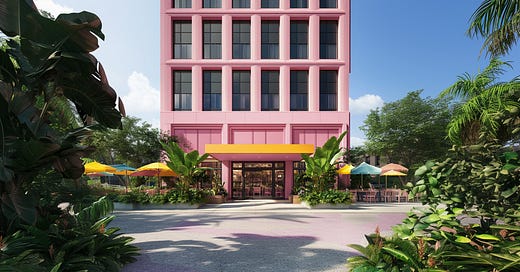“World Building.”
You may be thinking: oh great, another fancy idea from No Walls Studio…something out of their big book of fancy ideas. Well, yeah. You’re right. The concept–and even the sound–of “World Building” feels academic. Boring and not relatable. Something out of Star Trek. 🤓
But actually, the idea of World Building headlines big conflicts that we’ve felt for a long time, that we believe are relevant–and critical to resolve–for every real estate development:
How strong do you pump the brand sauce in different types of spaces?
What dimensions of brand building do you emphasize in different types of spaces?
What experiences are inherently comfortable/uncomfortable in different types of spaces?
To provide a way of thinking about these answers, let’s first define the idea of World Building: this is the process of creating an immersive environment with an explicit story that shows up in every detail of the space.
It’s the difference between a hotel that just provides a bed and one that makes you feel like you’ve stepped into a Wes Anderson movie, where even the soap dish has a backstory.
It’s the art of crafting a universe that isn’t just seen, but felt. From the architecture to the music playing in the lobby, every element serves the narrative, transporting people out of the ordinary and into a brand’s world. And like any good story, world building works best when it’s tailored to the audience and context.
The most important thing to remember about World Building is that not all spatial brands need (or can handle) the same degree of it. World Building operates best on a spectrum, from subtle, ambient storytelling to full-on immersive experiences.
Three key factors influence where a brand should fall on this spectrum: Length of Stay, Level of Customization, and Context of Consumption (or as we like to call it, ‘Why Are They Even Here?’).
Length of Stay: How Long is Too Long?
The shorter the stay, the more immersive and imaginative the world building can be. In other words, a two-night stay can be full-on Alice in Wonderland, but a year-long lease probably shouldn’t feel like you’re living in the Upside Down. That’s because guests are willing to suspend disbelief and embrace a fully developed narrative when they’re only living in it for a short while. Here’s how this connects to different types of spaces:
Hotels: ideal for maximalist world building because people are there to escape. Look at the TWA Hotel in New York—an entire space designed around the glamour of 1960s air travel, back when ‘leg room’ was an actual thing. Themed rooms, narrative-driven amenities, and character-inspired service moments work perfectly because the guest can step in and out of the story in a matter of days (or even hours).
Restaurants and Retail: also ripe for more intense world building. A themed dining experience or a retail environment that feels like stepping into a different time period can create memorable moments without overstaying their welcome.
Homes and Long-Term Residences: subtle and curated world building is best here. People want a place to live their own lives within your brand. Softer narrative elements—like curated material palettes or poetic brand touches—work better because they provide context without demanding constant participation. Side note: ironically, these types of spaces warrant the most intense brand foundation building because they rely on deep value proposition development rather than more explicit and obvious expressions.
Level of Customization: Who’s the Main Character?
In high-customization environments, the world building has to be flexible enough to let users shape the narrative.
Office buildings: high on customization for the corporate brand, so the world building should provide a backdrop, not a script. Office designers should leave room for companies to cultivate their employer-brand promises – all, within the context of an environment that has a clear value proposition (take the example of an office building for creative agencies…every company should have space to define their narrative within that intentional setting).
Apartments and Multi-Family Housing: brand narratives should show up differently as you graduate through common spaces (where the extras of the movie hang out) into private units (where the main characters spend most of their time). Be brand-forward in the common areas. Be brand subtle when you move into the units and bedrooms so that residents can write their own scripts. Think: a pop of brand color in the bathroom and intentional fixtures, but not a painted logo on the side of their unit wall. It’s critical to be present, just don’t be obnoxious.
Themed Entertainment Venues: here, the narrative is fixed and the user is a visitor, not the protagonist. You can go all out on storytelling. Think: theme parks or immersive theater experiences like Alamo Drafthouse or Cirque de Soleil.
Context of Consumption: Why Are They Here?
The purpose of the space shapes the level of narrative intensity. If the brand is part of a larger journey or ritual, the world building should be designed to amplify that purpose.
Wellness and Spa Spaces: These are about transformation or rejuvenation, so the world building should be sensory and transportive. For example, at Aire Ancient Baths you’re basically bathing in an ancient Roman fever dream. Scents, sounds, and tactile elements should create a mood without a heavy narrative.
Co-Working: People are there to create within your story. Brand narratives should be about setting a clear tone or philosophy – providing your users all of the tools and inspiration to build something.
Event Spaces: These are about moments and memories, so the world building should be flexible enough to be remixed or reinterpreted by different users, but strong enough to leave a lasting impression.
No matter the type of space, think of world building like an ecosystem, not just an environment. The key is to treat the process of developing these worlds as an ongoing dialogue with your guests or residents, continuously evolving as they live in and contribute to the story.
World building isn’t about making fake worlds. It’s about making real worlds more meaningful. And if you do it right, your brand won’t just exist—it will live in people’s memories long after they’ve left the building.
Missed our feature in The Brand Identity? Check it out now.
🚨 WHO IS NO WALLS STUDIO (AND WHAT DO WE DO)?
No Walls Studio is a design and brand consultancy that helps real estate developers create spaces that people love.
Our mission is to make sameness extinct in real estate, which means that everything we do comes with new ideas and unique angles — all, grounded in a deep understanding of culture and consumers.
We do three things for our clients (often, all in the same project):
Research & Insights
Brand Development
Spatial Experience Design
Want to work with us or learn more?
















